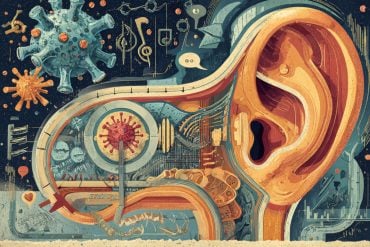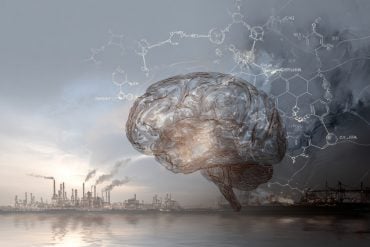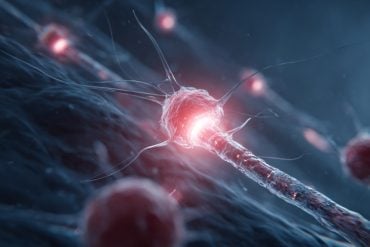Summary: New imaging technology allowed researchers to map how Sting’s brain organizes music.
Source: McGill University.
What does the 1960s Beatles hit “Girl” have in common with Astor Piazolla’s evocative tango composition “Libertango”?
Probably not much, to the casual listener. But in the mind of one famously eclectic singer-songwriter, the two songs are highly similar. That’s one of the surprising findings of an unusual neuroscience study based on brain scans of the musician Sting.
The paper, published in the journal Neurocase, uses recently developed imaging-analysis techniques to provide a window into the mind of a masterful musician. It also represents an approach that could offer insights into how gifted individuals find connections between seemingly disparate thoughts or sounds, in fields ranging from arts to politics or science.
“These state-of the-art techniques really allowed us to make maps of how Sting’s brain organizes music,” says lead author Daniel Levitin, a cognitive psychologist at McGill University. “That’s important because at the heart of great musicianship is the ability to manipulate in one’s mind rich representations of the desired soundscape.”
Lab tour with a twist
The research stemmed from a serendipitous encounter several years ago. Sting had read Levitin’s book This Is Your Brain on Music and was coming to Montreal to play a concert. His representatives contacted Levitin and asked if he might take a tour of the lab at McGill. Levitin — whose lab has hosted visits from many popular musicians over the years – readily agreed. And he added a unique twist: “I asked if he also wanted to have his brain scanned. He said ‘yes’.”
So it was that McGill students in the Stewart Biology Building one day found themselves sharing an elevator with the former lead singer of The Police, who has won 16 Grammy Awards, including one in 1982 for the hit single “Don’t Stand So Close To Me.”
Both functional and structural scans were conducted in a single session at the brain imaging unit of McGill’s Montreal Neurological Institute, the hot afternoon before a Police concert. A power outage knocked the entire campus off-line for several hours, threatening to cancel the experiment. Because it takes over an hour to reboot the fMRI machine, time grew short. Sting generously agreed to skip his soundcheck in order to do the scan.

Levitin then teamed up with Scott Grafton, a leading brain-scan expert at the University of California at Santa Barbara, to use two novel techniques to analyze the scans. The techniques, known as multivoxel pattern analysis and representational dissimilarity analysis, showed which songs Sting found similar to one another and which ones are dissimilar – based not on tests or questionnaires, but on activations of brain regions.
“At the heart of these methods is the ability to test if patterns of brain activity are more alike for two similar styles of music compared to different styles. This approach has never before been considered in brain imaging experiments of music,” notes Scott Grafton.
Unexpected connections
“Sting’s brain scan pointed us to several connections between pieces of music that I know well but had never seen as related before,” Levitin says. Piazzola’s “Libertango” and the Beatles’ “Girl” proved to be two of the most similar. Both are in minor keys and include similar melodic motifs, the paper reveals. Another example: Sting’s own “Moon over Bourbon Street” and Booker T. and the MG’s “Green Onions,” both of which are in the key of F minor, have the same tempo (132 beats per minute) and a swing rhythm.
The methods introduced in this paper, Levitin says, “can be used to study all sorts of things: how athletes organize their thoughts about body movements; how writers organize their thoughts about characters; how painters think about color, form and space.”
Funding: This research was supported by the National Sciences and Engineering Research Council of Canada.
Source: Chris Chipello – McGill University
Image Source: This NeuroscienceNews.com image is credited to Owen Egan.
Original Research: Abstract for “Measuring the representational space of music with fMRI: a case study with Sting” by Daniel J. Levitin and Scott T. Grafton in Neurocase. Published online August 12 2016 doi:10.1080/13554794.2016.1216572
[cbtabs][cbtab title=”MLA”]McGill University. “Don’t Scan So Close To Me: Scanning Sting’s Musical Brain.” NeuroscienceNews. NeuroscienceNews, 15 August 2016.
<https://neurosciencenews.com/sting-music-brain-scan-4843/>.[/cbtab][cbtab title=”APA”]McGill University. (2016, August 15). Don’t Scan So Close To Me: Scanning Sting’s Musical Brain. NeuroscienceNew. Retrieved August 15, 2016 from https://neurosciencenews.com/sting-music-brain-scan-4843/[/cbtab][cbtab title=”Chicago”]McGill University. “Don’t Scan So Close To Me: Scanning Sting’s Musical Brain.” https://neurosciencenews.com/sting-music-brain-scan-4843/ (accessed August 15, 2016).[/cbtab][/cbtabs]
Abstract
Measuring the representational space of music with fMRI: a case study with Sting
Functional brain imaging has revealed much about the neuroanatomical substrates of higher cognition, including music, language, learning, and memory. The technique lends itself to studying of groups of individuals. In contrast, the nature of expert performance is typically studied through the examination of exceptional individuals using behavioral case studies and retrospective biography. Here, we combined fMRI and the study of an individual who is a world-class expert musician and composer in order to better understand the neural underpinnings of his music perception and cognition, in particular, his mental representations for music. We used state of the art multivoxel pattern analysis (MVPA) and representational dissimilarity analysis (RDA) in a fixed set of brain regions to test three exploratory hypotheses with the musician Sting: (1) Composing would recruit neutral structures that are both unique and distinguishable from other creative acts, such as composing prose or visual art; (2) listening and imagining music would recruit similar neural regions, indicating that musical memory shares anatomical substrates with music listening; (3) the MVPA and RDA results would help us to map the representational space for music, revealing which musical pieces and genres are perceived to be similar in the musician’s mental models for music. Our hypotheses were confirmed. The act of composing, and even of imagining elements of the composed piece separately, such as melody and rhythm, activated a similar cluster of brain regions, and were distinct from prose and visual art. Listened and imagined music showed high similarity, and in addition, notable similarity/dissimilarity patterns emerged among the various pieces used as stimuli: Muzak and Top 100/Pop songs were far from all other musical styles in Mahalanobis distance (Euclidean representational space), whereas jazz, R&B, tango and rock were comparatively close. Closer inspection revealed principaled explanations for the similarity clusters found, based on key, tempo, motif, and orchestration.
“Measuring the representational space of music with fMRI: a case study with Sting” by Daniel J. Levitin and Scott T. Grafton in Neurocase. Published online August 12 2016 doi:10.1080/13554794.2016.1216572






